When you think of business process transformation (BPT), you might think of complicated, time-consuming endeavors and endless paperwork. However, the reality is that BPT can be relatively straightforward, and it doesn’t need to take a long time to implement.
BPT is a strategic initiative that involves a thorough analysis, review, and overhaul of existing business processes. The primary aim is to enhance operational resilience, boost productivity, and improve overall effectiveness. In the current digital era marked by rapid technological advancements and evolving customer experiences, BPT is gaining paramount importance.
Unsurprisingly, Business Process Transformation (BPT) has emerged as a crucial methodology to stay competitive and efficient. According to Gartner, 91% of businesses are engaged in some form of digital initiative, with BPT at the center of it all.
This guide will take you through the essentials of BPT, from fundamental concepts to more intricate details. You’ll learn how to identify potential areas for improvement within your organization’s existing processes and understand how to leverage cutting-edge technologies to facilitate proper digital transformation.
- What is business process transformation?
- What is the business process transformation process?
- What factors are fueling the need for business process transformation?
- Why does business process transformation fail?
- Business process transformation in a nutshell
- Phase 3: Implement and Monitor
- What’s next for business process transformation?
What is business process transformation?
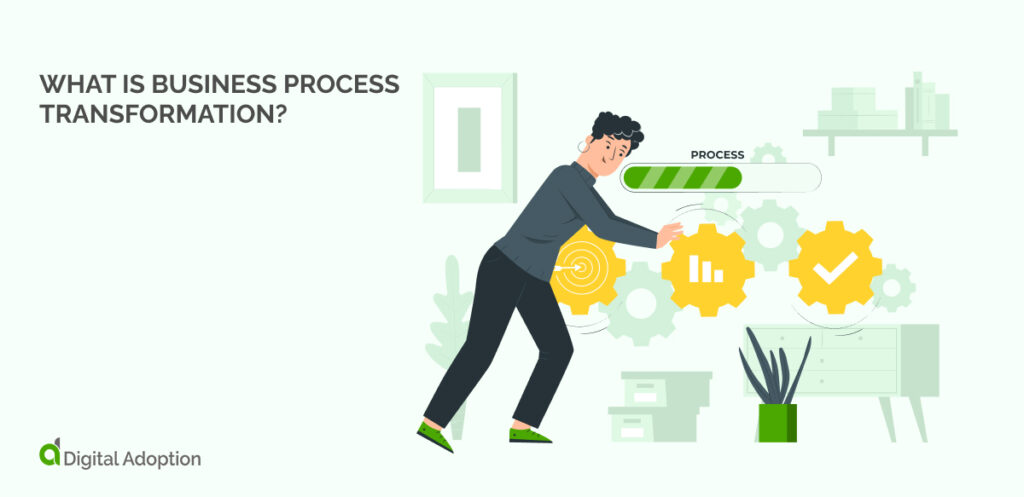
Business process transformation is a strategic redesign of an organization’s core business operations to improve efficiency, enhance customer service or boost performance. It involves reconfiguring workflows, processes, and systems, often leveraging digital technologies, to substantially improve productivity and business outcomes.
What is the business process transformation process?
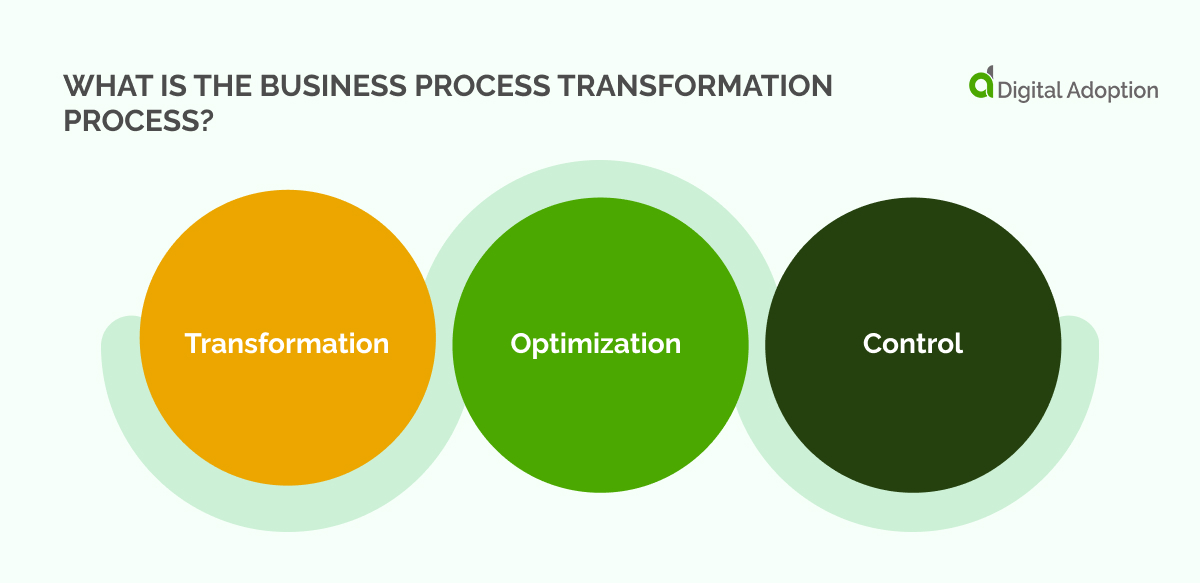
Business process transformation programs encompass the comprehensive cycle of TRANSFORM-OPTIMIZE-CONTROL.
This includes formulating strategies, reimagining work processes, facilitating execution, and monitoring outcomes. By enhancing word choice, structure, readability, and eloquence, we can elevate the quality of the content while preserving its original meaning.
- Transformation
Transformation refers to the complete overhaul and redesign of business processes to dramatically improve critical performance measures, such as cost, service, quality, and speed. This process often involves rethinking the fundamental ways an organization conducts its business and can lead to significant changes in business strategy.
For instance, a company might transform its customer service process from reactive (responding to complaints) to proactive (predicting issues and addressing them before they become problems). This could involve implementing new technology to monitor product usage data, training staff to use this data to anticipate customer issues, and creating new policies to guide proactive customer service.
- Optimization
Optimization is the process of making the best or most effective use of a situation or resource within a business process. This step involves refining and enhancing the processes to boost efficiency, reduce waste, and increase profitability.
For example, a manufacturing company might optimize its production process by introducing automation technology. This can reduce manual labor, minimize errors, speed up production times, and ultimately lower costs. It also involves tweaking supply chain processes to ensure raw materials are sourced cost-effectively and timely.
- Control
Control is the final stage of business process transformation. It involves monitoring and adjusting the new processes to ensure they deliver the desired results. Control mechanisms include performance metrics, audits, and feedback systems.
For instance, after introducing a new sales process, a company might track key performance indicators (KPIs) like the number of sales, revenue, and customer satisfaction scores. If these KPIs are not meeting targets, the company can identify the issues and adjust the process accordingly.
Effective control helps maintain the gains achieved through transformation and optimization and ensures that the processes continue to adapt to changing business needs and challenges. It’s a continuous and dynamic process, as businesses must keep evolving to stay competitive and meet their objectives.
What factors are fueling the need for business process transformation?
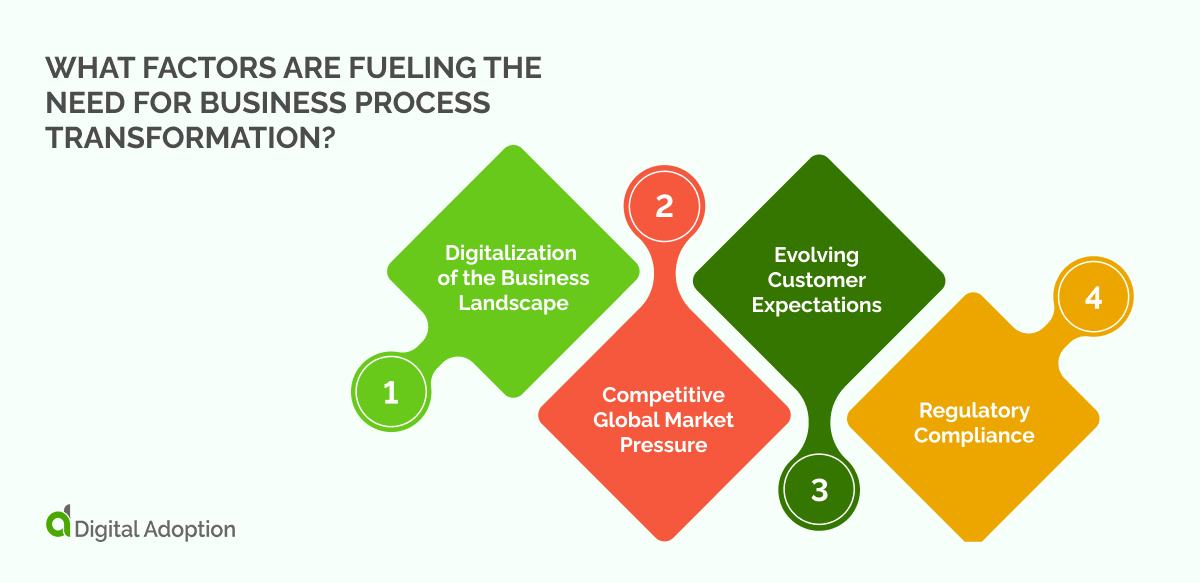
By 2022, the investment in digital maturity initiatives and transformation programs is set to skyrocket to an astonishing two trillion dollars worldwide. But here’s the kicker: a mere 10% of companies rake in a whopping 80% of the digital revenues.
Four major factors are fueling the rising demand for business process transformation:
- Digitalization of the Business Landscape: The swift evolution of digital technologies such as artificial intelligence, machine learning, cloud computing, and data analytics is driving businesses to modernize their processes. These innovative digital solutions challenge traditional models, offering improved efficiency, speed, and enhanced customer experience.
- Competitive Global Market Pressure: With intensifying global competition, businesses feel compelled to optimize their operational processes. Business process transformation allows them to gain an edge, better utilize resources, increase productivity, and adapt more quickly to changing market dynamics.
- Evolving Customer Expectations: In the digital era, customers demand personalized, seamless, and immediate services. To meet these high expectations, businesses must transform their processes, adopting a customer-centric approach that prioritizes the customer experience.
- Regulatory Compliance: As regulations become more stringent and complex, businesses must ensure compliance to avoid penalties. Agile and transparent processes, facilitated by business process transformation, can help companies to adhere to these regulations.
Why does business process transformation fail?
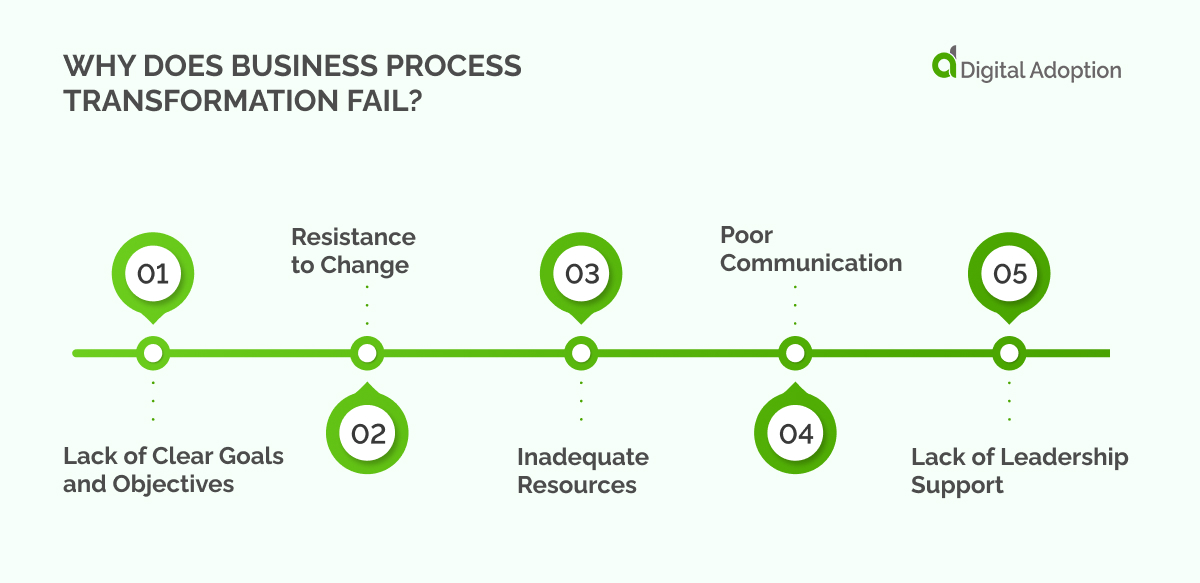
It’s often said that 70-90 percent of transformation initiatives fail to meet their desired outcomes. While there are numerous reasons why a business process transformation program might fail, there are some key common pitfalls:
- Lack of Clear Goals and Objectives: Transformations often fail when there is no clear understanding of what the company is trying to achieve. The lack of well-defined goals and objectives can lead to confusion, misalignment, and, ultimately, failure. Companies must clearly define their goals and objectives before embarking on a transformation journey.
- Resistance to Change: Change is often met with resistance, especially in large organizations. New processes and systems may threaten employees, leading to resistance and slow adoption rates. Successful transformations require strong change management strategies that address employee concerns and promote acceptance of new ways of doing things.
- Inadequate Resources: Business process transformation often requires significant resources, including time, money, and personnel. If these resources are not adequately allocated, the transformation effort may be doomed from the start. Companies must ensure they have the necessary resources before starting a transformation initiative.
- Poor Communication: Effective communication is key to any successful transformation. Employees who do not understand why changes are being made or how they will benefit are less likely to support the transformation. Companies must clearly and consistently communicate their vision and the transformation’s benefits.
- Lack of Leadership Support: Without strong transformational leadership and support, digital initiatives are likely to falter. Leaders must not only endorse the transformation but also actively participate in it. They should set the tone by modeling the behaviors and attitudes necessary for success.
Business process transformation in a nutshell
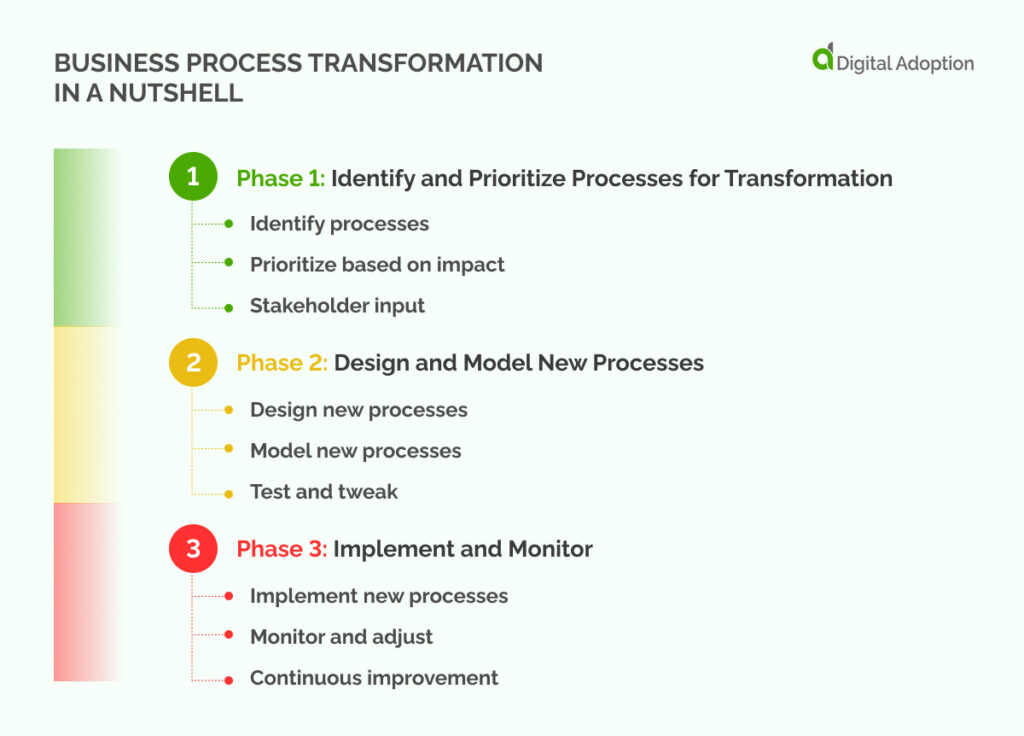
We’ve identified three phases of business process transformation below that will help you drive digital success:
Phase 1: Identify and Prioritize Processes for Transformation
The first phase in optimizing business process transformation is identifying and prioritizing the processes that need to be transformed. This involves a detailed analysis of current business operations.
- Identify processes: Start by mapping out all the business processes, focusing on those directly affecting your customers or involving multiple departments. This could range from billing procedures to customer service protocols.
- Prioritize based on impact: Once you’ve identified potential processes for transformation, prioritize them based on their potential impact on the business. Consider factors like cost savings, improved customer satisfaction, and increased operational efficiency.
- Stakeholder input: Engage stakeholders from relevant departments. Their input can help identify hidden inefficiencies, and they will also play a key role in implementing changes.
This phase lays the groundwork for successful transformation. By identifying the right processes and involving stakeholders early on, businesses can ensure that their transformation efforts will have the greatest impact.
Phase 2: Design and Model New Processes
In this phase, you design and model the new processes. This involves creating detailed plans for how the transformed processes will work.
- Design new processes: Using the information gathered in the identification phase, design new processes that address the identified inefficiencies. This should involve stakeholders from across the business to ensure the new processes will be effective and feasible.
- Model new processes: Use process modeling tools to visually represent the new processes. This helps everyone involved understand exactly how the new processes will work and how they differ from the old ones.
- Test and tweak: Run simulations or pilot programs to test the new processes. This allows you to identify any issues or inefficiencies before the new processes are fully implemented.
This phase aims to create efficient, effective processes that meet the needs of the business and its customers. Companies can ensure their transformations are successful by designing, modeling, and testing the new processes.
Phase 3: Implement and Monitor
The final phase involves implementing and monitoring the new processes to ensure they deliver the desired results.
- Implement new processes: Once designed and tested, it’s time to implement them. This involves training staff, updating systems, and possibly reorganizing departments or roles.
- Monitor and adjust: After implementation, closely monitor the new processes to ensure they work as expected. Use KPIs and other metrics to measure their effectiveness. If necessary, make adjustments to further improve efficiency.
- Continuous improvement: Business process transformation should be an ongoing effort. Regularly review and update your processes to ensure they continue to meet the needs of the business and its customers.
This phase aims to verify that the newly implemented processes are yielding the intended outcomes. Through vigilant monitoring and necessary adjustments, businesses can consistently optimize their operational workflows for optimal efficiency and effectiveness.
What’s next for business process transformation?
Business process transformation is on the brink of a major evolution. As we move forward, businesses increasingly lean towards digitalization, with Artificial Intelligence (AI) and automation at the forefront. These technologies are set to redefine traditional business processes, making them more efficient and effective.
AI is poised to take over repetitive tasks, freeing human resources for more strategic roles. It can analyze large volumes of data, identify patterns, and provide actionable insights, leading to improved decision-making. Meanwhile, automation will streamline workflows, eliminate bottlenecks, and reduce operational costs.
Integrating AI and automation will create intelligent automation tools that will not only automate tasks but also learn and adapt over time, enhancing process efficiency and accuracy.
However, this transformation isn’t without challenges. Businesses must overcome hurdles like data privacy concerns, workforce management, and system integration complexities. But with careful planning and execution, these obstacles can be managed.
The future of business process transformation lies in embracing AI and automation. Businesses that adapt to these changes will be better positioned to thrive in the competitive market landscape.

 FACT CHECKED
FACT CHECKED







